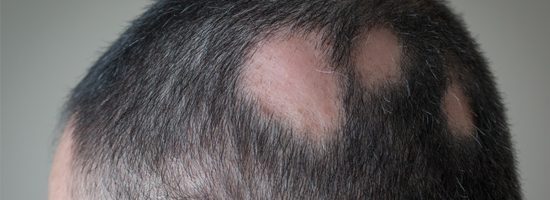Alopecia or hair loss is a common reason why patients, male and female make an appointment to see us. Hair loss can cause a lot of anxiety for many people. Medical conditions need to be excluded as a cause of hair loss. In many cases the hair loss is self-limiting. In other people it is inherited such as in male pattern baldness and female pattern thinning. Newer, more effective medical treatments are becoming increasingly available as more research is done globally.

Alopecia (Hair Loss)
Alopecia or hair loss particularly scalp hair plays a crucial role in self-identity, body image and attractiveness. Loss of scalp hair can be very distressing for some people. Hair loss can negatively impact one’s sense of personal and social acceptance in society.
Alopecia can be severe psychological impact on patients and can lead to depression, anxiety and social phobia. Patients with alopecia areata described the initial diagnosis as ‘devastating’,’ traumatising’, and ‘terrifying’ in a study in the Journal of Patient Reported Outcomes. Hair loss in areas visible to other people was associated with the greatest psychosocial burden.
Hair loss can be emotionally devastating and have a large impact on self-esteem and social confidence. Social phobia secondary to alopecia can manifest as diminished social activities, fidgeting and other signs of insecurity such as avoidance of eye contact.
Alopecia can be diffuse if it is affecting the entire scalp or it could localise which is characterised by patchy hair loss.
Diffuse Alopecia
Diffuse alopecia is very common and the incidence increases with age. To understand alopecia 1 needs to understand the hair cycle. Her cycles through 3 phases
Anagen is the growth phase and last 2 to 6 years.
Catagen is the resting phase and can last 4 to 6 weeks.
T lesion is the resting phase and last 2 to 3 months and hair loss predominantly occurs in the telogen phase when the hair shaft is released from the hair follicle.
Classification of diffuse alopecia
Diffuse alopecia can be classified into excessive hair shedding and conditions that cause hair thinning.
Excessive hair shedding is often due to a chronic telogen effluvium. This is the most common cause of diffuse hair shedding. Excessive shedding of telogen hairs can occur a few weeks to a few months after the triggering event. Common causes include postpartum hair loss 6 to 16 weeks after the birth of a child, however, the most common cause is iron deficiency anaemia. Other medical causes include hypothyroidism, lupus erythematosus major blood loss and severe stress. There is also a large group where the cause is unknown and this is the idiopathic group of patients with chronic telogen effluvium. Medications can cause a drug-induced alopecia. Kidney and liver diseases, malnutrition or infection such as syphilis can also lead to diffuse alopecia.
A chronic telogen effluvium can unmask another cause of hair loss such as androgenetic alopecia which is also called male pattern hair loss or female pattern hair loss.
Anagen effluvium can also occur where there is premature termination of hair growth and abrupt hair shedding. The most common cause of a chemotherapy drug is and usually begins 1 or 2 weeks after starting treatment. It can also lead to loss of body hair, eyebrow hair and eyelashes. Alopecia areata can cause widespread and diffuse hair loss of the entire scalp leading to alopecia totalis or complete loss of body hair called alopecia universalis.
Adrogenetic Alopecia
This is the name given to male pattern hair loss or female pattern hair loss. It is due to a genetic disposition and is due to circulating androgens around the hair bulbs.
In males, it can lead to bitemporal recession and balding at the vertex and frontal regions.
In females, it is also due to a genetic predisposition. The role of androgens is thought to play a role in causing miniaturisation of the hair bulbs and therefore for thinning of the scalp hair particularly in the crown region and widening of the midline part. Female pattern thinning can be aggravated by medical conditions such as polycystic ovarian syndrome.
The management of androgenetic alopecia is entirely different in males and females. Different oral treatments are available and it is constantly changing. To learn more, see your dermatologists.
Counselling and referral to national and international patient support groups should be encouraged. These support groups act as mentors and offer support, improve self-esteem and take the focus off their disease.
Patients with alopecia areata were found to be more susceptible to developing a major depressive disorder by 34%. Major depressive disorder was found to increase the risk of developing alopecia areata by 90%.
What is new in the management of alopecia areata?
The FDA has approved a Janus Kinase Inhibitor in the USA. It is the first and only approved drug for AA. It has not been approved for use in Australia for AA.
Some topical medications can be used in the management of androgenetic alopecia.
Current treatments include topical and intralesional steroids and occasionally oral steroids. Topical JAK inhibitor has also been used with some success.
Female pattern hair loss
This is a common condition and is increasingly common with age. The current most effective treatment is an oral 5 alpha-reductase inhibitor.
Male pattern hair loss
This is also a common condition and the incidence increases rapidly with age. A 5 alpha reductase inhibitor has been approved by the TGA for use in male patients in Australia.
Hair transplantation
This is another suitable option once the hair loss has stabilised. In expert hands 90% of the hair that is transplanted successfully grows in the new permanent location. To learn more about hair transplantation see your dermatologist.
